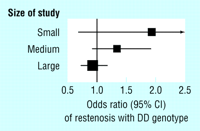This week in the BMJ
Volume 325, Number 7363, Issue of 7 Sep 2002Public defibrillators are not the best way to improve survival
Children from ethnic minorities use GPs more and secondary care less
Link between polymorphism and coronary restenosis may be due to bias
Adolescents like health promotion consultations
but they have little effect
Nitrous oxide may be a hazard after retinal surgery
NHS nursing shortages: retention is the biggest problem
Public information on US clinical trials is inadequate
Public defibrillators are not the best way to improve survival
Defibrillators for use by the public have less impact on survival than
other interventions, yet the Department of Health is providing 700 public access defibrillators in 72 sites across England. Pell and
colleagues (p 515) used data from the Scottish Ambulance Service and
hospital records to model the potential impact of public access
defibrillators on survival after cardiopulmonary arrest outside
hospital. They show that 79% of arrests occurred in sites unsuitable
for public access defibrillators. Extending "first responder"
defibrillation to police and firefighters and encouraging bystander
cardiopulmonary resuscitation would, they argue, be a better strategy.

(Credit: AP PHOTO/CHARLIE BENNETT)
Children from ethnic minorities use GPs more and secondary care less
Children and young people from ethnic minorities make more use of
general practitioners' services but are less likely to be referred for
secondary care than children generally. Saxena and colleagues (p 520)
compared self reported health status and health service use between
different ethnic minority and social class groups in 6648 children and
young adults in England. Despite socioeconomic disadvantage, Asian children reported less illness than the general population. General practitioners' attitudes towards patients from
ethnic minorities need to be explored to explain the differences in the
use of primary and secondary care.

(Credit: INSIGHT)
Link between polymorphism and coronary restenosis may be due to bias
Studies have suggested that genetic susceptibility is an important
determinant of coronary restenosis after percutaneous coronary intervention. In a meta-analysis of 16 published studies of the angiotensin converting enzyme insertion or deletion polymorphism and
restenosis, however, Bonnici and others (p 517) showed weaker associations between the DD genotype and restenosis in larger and more
rigorous studies than in other studies. They conclude that biases in
genetic epidemiological studies of customary size and quality can
produce artefactual associations at least as large as those that might
be realistically expected for common polymorphisms in complex diseases.

Adolescents like health promotion consultations but they have
little effect
but they have
little effect
Health promotion consultations for teenagers in general practice
are well received but not very effective in changing behaviour. In a
randomised controlled trial Walker and colleagues (p 524) found that a
significantly higher proportion of the intervention group showed
positive change for at least one behaviour (diet, exercise, smoking, or
drinking alcohol) at three months. But this did not persist to 12 months. The intervention was simple, cheap, and well received, with
97% of teenagers saying they would recommend it to a friend.
Nitrous oxide may be a hazard after retinal surgery
Patients who have had surgery for retinal detachment in which
intraocular gases have been used should not be given anaesthetics that
include nitrous oxide for some months afterwards. Yang et al (p 532)
describe a patient who was given general anaesthesia with nitrous oxide
shortly after surgery for retinal detachment and lost the sight in his
eye as a result. The intraocular gases used as tamponading agents in
vitreoretinal surgery may persist in the eye for up to three months.
Nitrous oxide causes the gas bubble to expand, dramatically increasing
the intraocular pressure and causing ischaemic retinal damage.

NHS nursing shortages: retention is the biggest problem
About a third of newly graduating nurses in the United Kingdom do
not register to practise, and no one knows why. In their two part
discussion of the nursing crisis in the NHS (pp 538, 541)
Finlayson and colleagues document the changing structure of the nursing
profession in the UK, with fewer nurses trained in the UK and a rising
average age. Staffing shortages which raise costs and reduce
morale
which raise costs and reduce
morale are most acute in hospitals in London and other inner cities.
The government is trying to tackle the major underlying causes by
increasing pay, recruiting extra nurses to help relieve heavy
workloads, extending the clinical roles of nurses, and trying to
counter racism and violence and foster family friendly policies.
But, argue the authors, these initiatives may not be enough. Workforce
issues are still nowhere near the top of managers'
agendas.
are most acute in hospitals in London and other inner cities.
The government is trying to tackle the major underlying causes by
increasing pay, recruiting extra nurses to help relieve heavy
workloads, extending the clinical roles of nurses, and trying to
counter racism and violence and foster family friendly policies.
But, argue the authors, these initiatives may not be enough. Workforce
issues are still nowhere near the top of managers'
agendas.

Public information on US clinical trials is inadequate
In the United States, where it is mandatory to register clinical
trials for serious or life threatening diseases, many such trials are
not listed in any publicly available trials register. Manheimer and
Anderson (p 528) used major US trial registers to search for
information on 33 phase III trials of drugs known to be under
investigation for prostate and colon cancer: about 34% were not
identified in any of the registers. The authors conclude that, despite
the existence of hundreds of predominantly online registers of drug
trials, information is incomplete, with non-standardised language, and
is unlikely to meet the needs of clinicians and others.